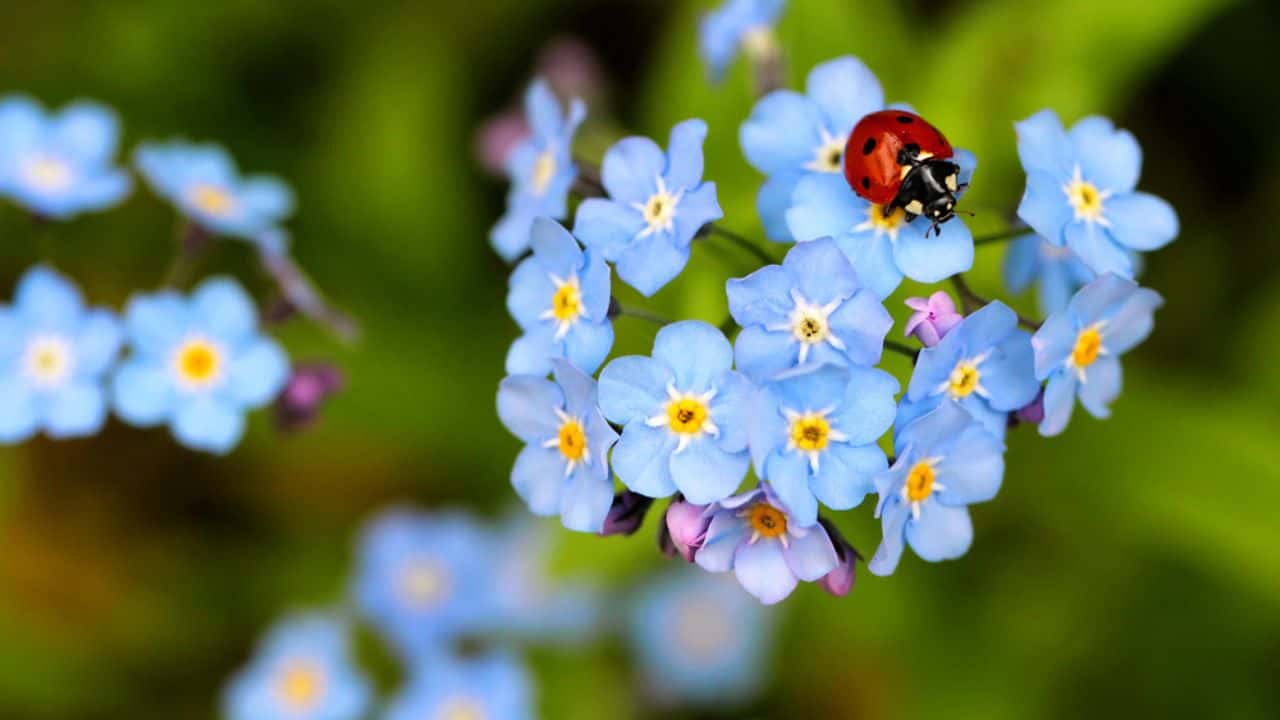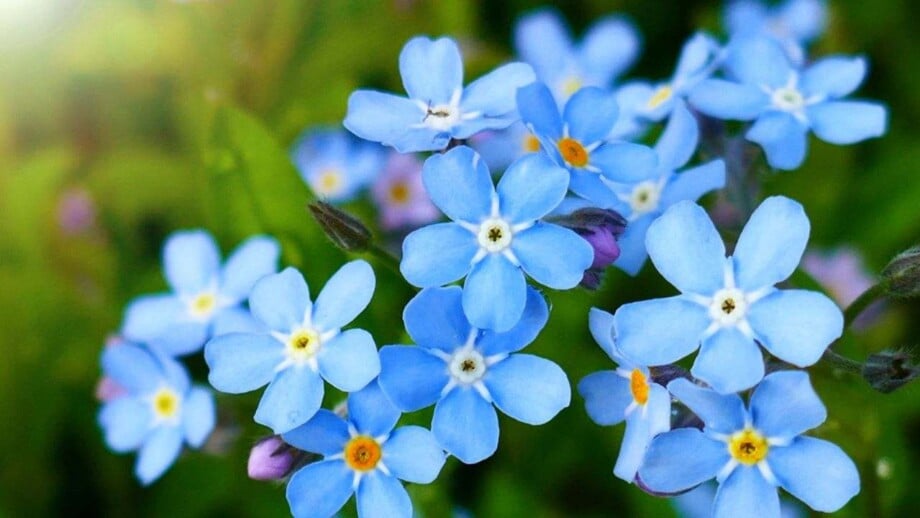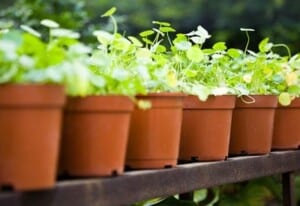Forget me not is loved and admired for its lovely blue flowers with yellow centers. These delicate flowers belong to the genus Myosotis in the Boraginaceae family. Forget me not flowers typically have a diameter of approximately half an inch and five petals, although there is some variation within the species itself.
Despite being mostly recognized for its blue flowers, some varieties can also produce pink, white, or even a combination of the three. An added bonus is that you get two colors for the price of one since the buds that precede the blue flowers are pink in color. These plants have a long history of use as astringents to treat wounds and a variety of other medical conditions.
Forget-me-nots are pretty flowers that are easy to grow and look great in woodland gardens and landscapes. The flowers attract bees and butterflies, and the plants are resistant to deer.
They are prolific bloomers that will flower for most of the growing season if grown properly. In addition to giving your yard a pretty shade of blue, they are rich in lore and symbolism.
Although forget-me-not is technically a short-lived perennial, most grow them as biennials, sowing seeds in the midsummer and enjoying the blooms the following year. It requires deadheading if you don’t want it to overgrow a space, but it is simple to maintain.
Note: Since this plant reseeds readily, it is invasive in many states and is considered a noxious weed in the Midwest, one of the U.S. regions where it has naturalized.

Botanical Name: Myosotis sylvatica
Common Name: Forget me not, woodland forget me not, ornamental forget me not
Family: Boraginaceae
Plant Type: Biennial
Hardiness Zones: 3 – 8 (USDA)
Sun Exposure: Full to partial sun
Soil Type: Moist, well-draining
Soil pH: 6.0 – 8.0 (Slightly acidic to mildly alkaline)
Height: 1 ft tall
Spacing: 10 inches apart
Bloom Time: Spring and summer
Flower Colors: Blue, pink, white, and yellow
Native Area: Europe

Quick Guide: Planting, Growing & Caring for Forget Me Nots
- Forget me nots readily reseed and produce beautiful, small flowers that are usually blue with yellow centers.
- You can grow them in either full sun or partial shade, although it’s recommended to provide them with some afternoon shade when growing in southern regions.
- Water them to maintain evenly moist soil which will also help these flowers have the longest blooming period.
- Deadhead if you want to reduce reseeding.
- It’s important to note that it’s invasive in many states and is considered a noxious weed in the Midwest.
Forget Me Not Symbolism
The word ‘Myosotis’ in the species name derives from Greek words meaning ‘mouse ear.’ This is because the foliage of the plant features tiny, pointed leaves that resemble mouse ears.
Myosotis scorpiodes, another forget-me-not variety, has an unusual common name, ‘scorpion grass,’ thanks to its flower clusters that curl like a scorpion’s tail.
The Alpine forget-me-not, or Myosotis alpestris, is Alaska’s state flower. It got its name before Alaska even became a state.
Interestingly, in 1917, the Alaskan Territory chose the flower to represent the territory, and because the people loved it so much, Alaska preserved the flower as its official emblem when it became a state.
For their symbolic significance, forget-me-nots are a common choice as a bridal flower. This is because historically these pretty blue flowers have been known to symbolize both true love and respect.
Giving someone one of these small blossoms is a pledge that you will never forget them and that you will think of them often. For this reason, they’re also considered a symbol of fidelity and faithfulness.
The forget me not is even used in art history to memorialize loved ones who have died. As a result, it frequently appears in funeral portraits.

How Did Forget Me Nots Get Their Name?
How forget me not got its name is truly intriguing, thanks to the many legends that surround its name
One legend tells about a German knight and his lady wandering along the Danube riverbanks. The woman saw pretty blue flowers, but the flow of the river had pulled them away, and they were about to disappear downstream.
Her gallant knight dove into the river in order to save the flowers. Unfortunately, the current was too strong for him. He threw the flowers over the edge and shouted “forget me not” (‘vergiss mein nicht’ in German) as the river swept him out to sea.
According to a different version of the story, the German knight didn’t intentionally jump into the river after the flowers. Rather, he was bending down to pick some for his lady when the weight of his armor forced him to fall into the water. He then yelled “forget me not” as he was being carried away by the current.
According to another German legend, God chose the name while naming flowers. This was the last flower to be named, and it cried out, “Forget me not, O Lord,” to which God replied, “That shall be your name!”

Forget Me Not Plant Care
Forget-me-not is an adaptable and versatile plant. It is resistant to rabbits and deer, attracts butterflies and bees, and even has many landscape uses.
You can use forget me nots as a ground cover, in woodland gardens, plant them in a pot for your porches and patios, or use them to bring classic beauty to your cottage gardens.
But since it spreads on its own, you should take care to stop it from self-seeding in places where you want a carefully controlled garden. To stop the unintended spread, deadhead any seed heads that develop along with any spent blooms.
Light
If you’re growing forget me nots in the north, you can easily grow them in either full sun or partial shade. However, when growing it in warmer southern regions, make sure the plant gets some afternoon shade. The plant will require more water the more sunlight it receives.
Soil
Forget me not plants thrive in rich, well-drained soil that’s consistently moist. They can, however, tolerate wet soil, and some species even grow in standing water.
Water
As mentioned above, forget me not tolerates wet soil but at the very minimum it requires evenly moist soil. This plant will need more water the more sunlight it receives. Aim to water consistently to keep the soil moist.
Temperature and Humidity
Forget-me-not can grow in six USDA zones all the way from zone 3 to 8 since it can handle both heat and cold well. However, because it is prone to powdery mildew disease, it isn’t a good choice for places with very humid and hot summers.
Fertilizer
Annually fertilize forget-me-nots with compost or an all-purpose fertilizer. Follow the directions on the package for how much fertilizer to use.
Pruning
The best way to maximize its aesthetic value is by grouping several plants together and allowing them to grow as large as possible. This is because even though the flowers are beautiful and bloom abundantly, they’re relatively small.
As a result, there is a disincentive to trimming back forget me not stems. However, deadhead the flowers if you want to reduce reseeding.
Overwintering
The forget-me-not is a hardy plant within its USDA zones. And so, you don’t need to do anything to prepare it for winter unless you want to grow it north of Zone 3.
How to Plant and Grow Forget Me Not
How to Propagate Forget Me Not
Forget-me-not reseeds by itself. As time goes on, it will start multiplying. Once introduced, it will remain in your garden for many years unless you deliberately eradicate it.
If you want to spread it, you can use this to your advantage by digging up some of the plants that have grown from the original and moving them to other places in the spring. Make sure to space them around 10 inches apart when doing so.

How to Grow Forget Me Not Flowers From Seed
Forget-me-not plants are easy to grow from seeds, as shown by the fact that they can spread and reseed readily by themselves. You only have to do a few simple things to add these spring flowers to your garden.
Start by purchasing a seed packet by early summer. Next, pick a location in the garden, and rake the ground there to make the soil easier to work with and smooth it out. Then spread the seeds across the area in the midsummer or early fall.
In colder regions, it’s best to sow seeds outdoors close to the last frost date in spring. Alternatively, you can start the seeds indoors around 8 to 10 weeks before the last frost date.
After that, water the area frequently and evenly enough to keep the soil moist. Seedlings will appear in the fall and the flowers will bloom by the following spring.
How to Get Forget Me Not to Bloom
Forget me not flowers are only around half an inch across but they grow abundantly. They’ll bloom for several weeks in April and May.
To encourage the longest blooming period and the most flowers, provide your plants with rich soil and keep it evenly moist. As a biennial or short-lived perennial that reseeds, forget me not blooms annually with minimal upkeep.
Common Pests and Plant Diseases for Forget Me Not
Fortunately, forget me nots are usually quite pest resistant. However, keep an eye out for aphids that may suck out the sap. When it comes to plant diseases, there are two that this plant is most susceptible to.
The first is powdery mildew which appears as a light-colored powdery coating on a plant’s leaves. Although it’s usually not fatal, it can temporarily ruin your plant’s appearance. Keep it at bay by avoiding overhead watering.
The other plant disease to watch out for is rust. Rust produces pustules which then rupture and discharge orange spores on the undersides of leaves. However, the yellow spots and marks it causes on the tops of the foliage are more noticeable.
The best way to prevent it, like with powdery mildew, is to keep the leaves dry whenever possible since it thrives in a damp environment. Avoid overhead watering to prevent both these plant diseases.
Other Flower Guides from Planet Natural:











